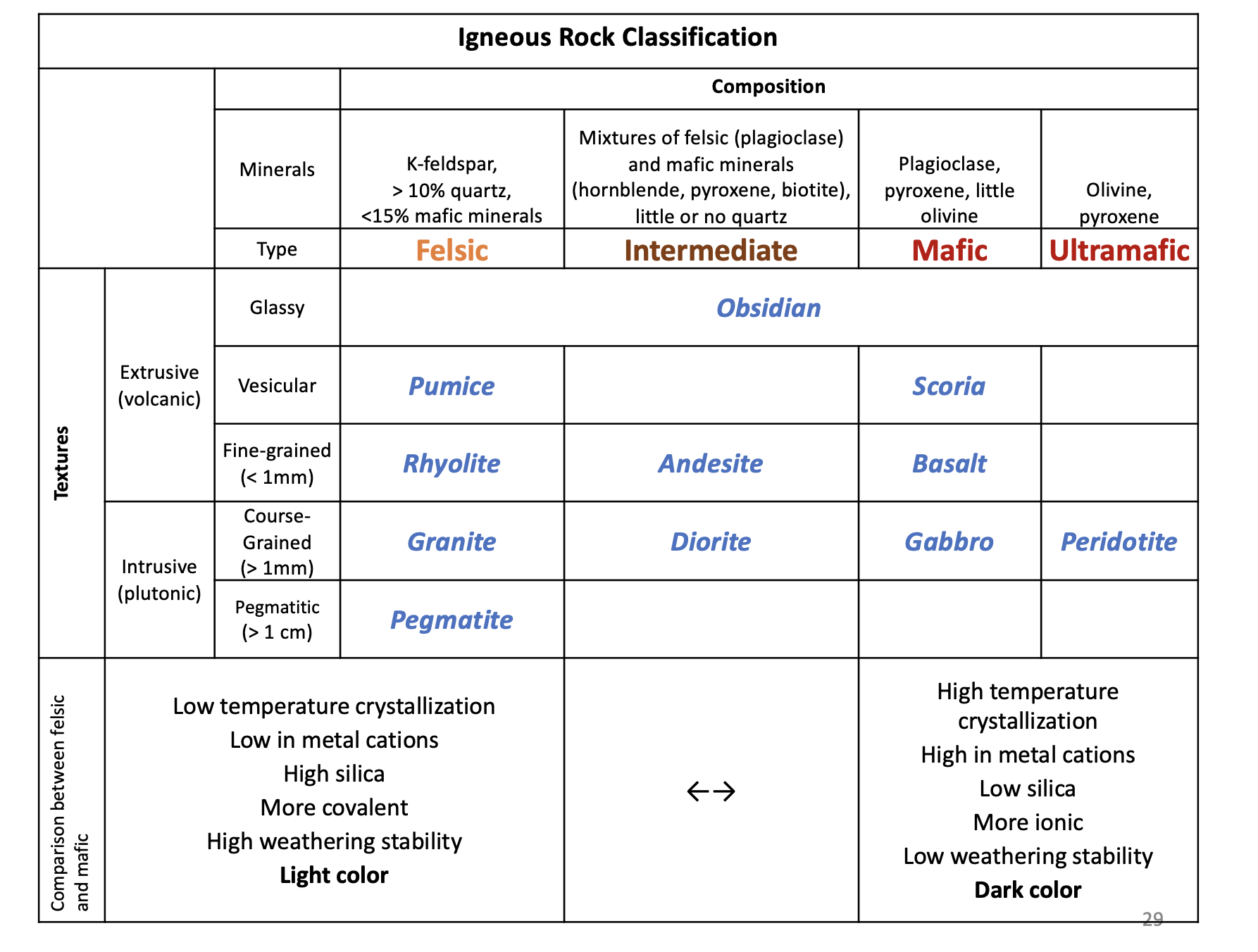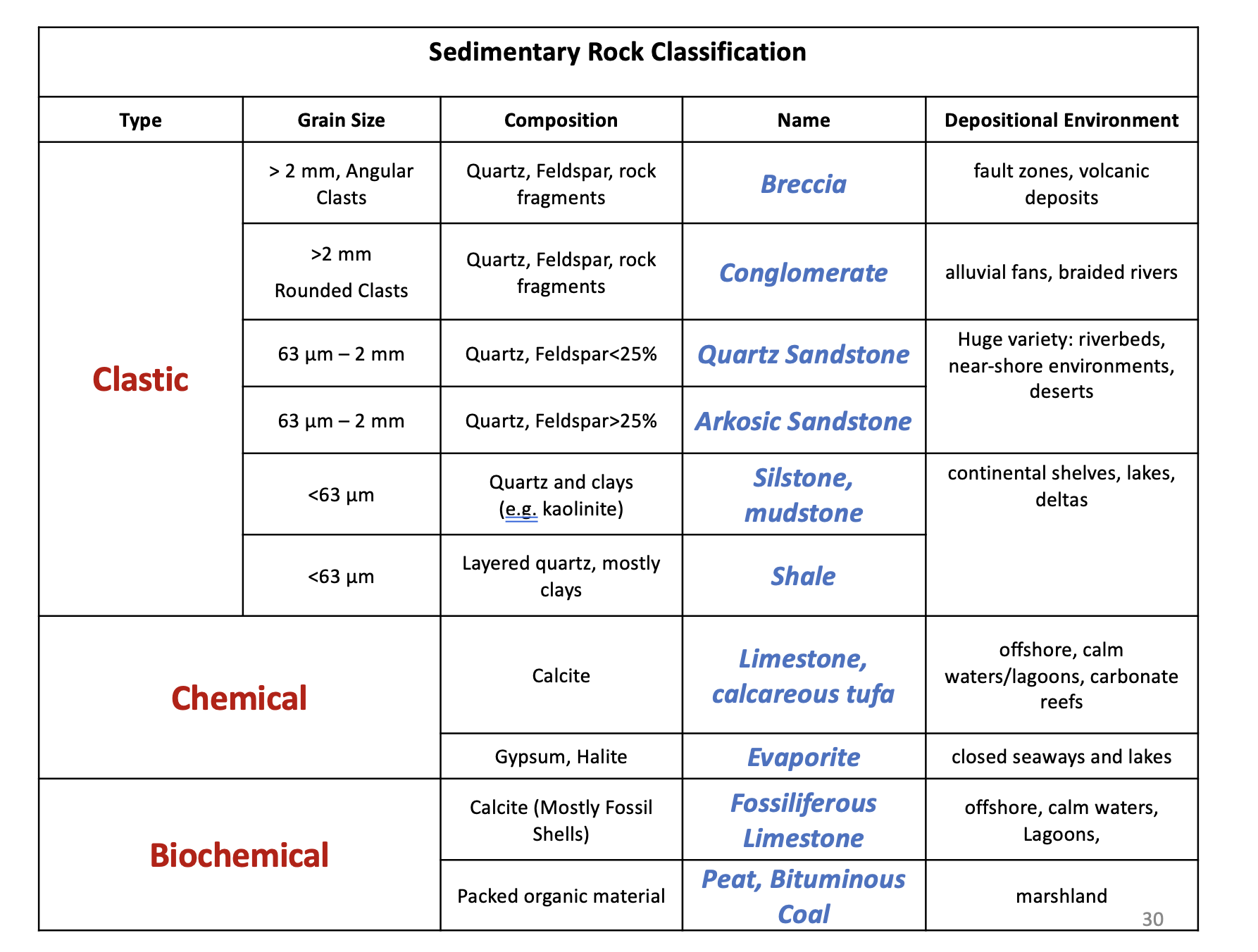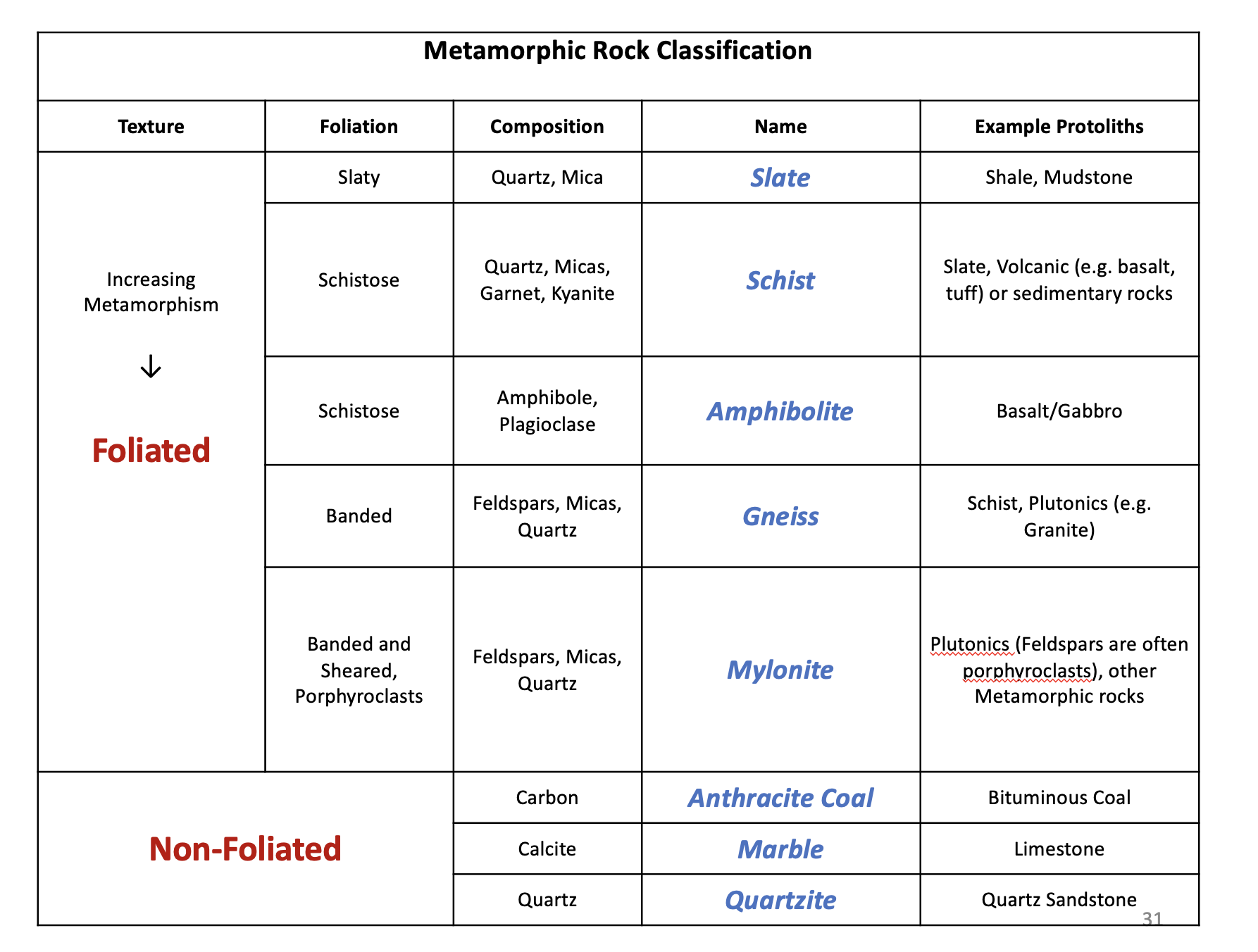This is part of the materials used in the Solid Earth class.
Igneous Rock

1) Textures
Description of the constituent parts of a rock and their sizes, shapes, and arrangements
- Glassy – produced by rapid cooling, enhanced in viscous (more felsic) magma
- Aphanitic – grains are too small to see with the naked eye, indicates rapid cooling
- Phaneritic – grains are visible with the eye and 1-10 mm in size, indicates slow cooling
- Pegmatitic – grains are very coarse (>1 cm), normally formed very late in plutonic processes from fluids
- Porphyritic – a volcanic rock with visible crystals within an aphanitic matrix, which is due to crystallization in the magma chamber prior to volcanic eruption
- Vesicular – contains many cavities that are the expression of former gas bubbles trapped inside cooling lavas
- Pyroclastic – rock contains large angular clasts of volcanic rock, which are the product of explosive volcanism
2) Composition
Igneous rocks are commonly classified by their composition, which can be inferred by looking at the minerals present within a rock (i.e., mineralogy) for the phaneritic samples, and can be inferred by their lightness (mafic vs. felsic) for the aphanitic samples.
- Ultramafic – These rocks are high in Mg and Fe and typically black or green. This is the composition of rocks within the mantle.
- Mafic – Typically dark colored and contain mafic minerals. When magma is first produced from partially melting ultramafic rocks, it is typically mafic in composition.
- Intermediate – Typically gray in color and contain more felsic minerals
- Felsic – Typically light in color and contain almost no mafic minerals
3) Rock Types
- Peridotite is an ultramafic rock predominantly composed of olivine with lesser amounts of clinopyroxene and orthopyroxene. The mantle is composed predominantly of peridotite.
- Basalt is one of the most common extrusive igneous rocks on the Earth because it can be formed in nearly all tectonic settings and is the main extrusive rock produced at the mid-ocean ridges. Basalt is very fine grained due to quick cooling, but it can often be porphyritic as well. It may either be dense or vesicular.
- Gabbro is the mafic, phaneritic compositional equivalent of basalt, formed by the solidification of magma below the surface of the Earth. Gabbro has abundant Ca-plagioclase and pyroxene and can contain olivine.
- Andesites are intermediate (intermediate color and intermediate composition), aphanitic igneous rocks found most commonly at convergent plate boundaries and some volcanic centers within continents.
- Diorite is an intermediate, phaneritic, intrusive equivalent of andesite and therefore you can see the plagioclase and amphibole crystals that make up the bulk of the rock. Diorites are often described as having a “salt and pepper” appearance because of the distribution of white and black minerals in them.
- Rhyolite is a felsic, aphanitic, igneous rock, commonly found at continental intra-plate volcanic centers (such as the Yellowstone Hot Spot) and sometimes at convergent plate boundaries overlying thick continental crust. Compared to basalts, rhyolites are much lighter colored and less dense.
- Granite is a felsic, phaneritic, intrusive equivalent of rhyolite. Granites are common igneous rocks that are formed above subduction zones as plutons of cooled magma that failed to ascend to the surface, and below continental intra-plate volcanic centers. Granite commonly contains K-feldspar, plagioclase, quartz and biotite.
4) Other distinctive textures found in igneous rocks
- Obsidian is glass. It is formed by quenching of a melt so there is not time for crystals to form. Obsidian can have a range of compositions, but commonly it has a felsic composition (although it is black due to the presence of magnetite microlites). It has a characteristic chonchoidal fracture.
- Pumice is an extrusive igneous rock formed from a frothy lava that was ejected, depressurized, and cooled rapidly. Pumice typically has a felsic composition and very low density.
- Scoria is an extrusive igneous rock that has abundant pores (or vesicles). The solid has a mafic composition. Though it does not look glassy, it is composed of glass and can be porphyritic.
- Pegmatite is an igneous texture used to describe the extremely large crystal size of minerals in a particular rock. Pegmatitic granites are often a source of rare earth bearing minerals and some gem stones including garnet, tourmaline, and beryl. It is commonly thought that pegmatites require some form of aqueous / silicate fluid enrichment to facilitate growth, which in turn brings in the rare earth and other “incompatible” elements. This specimen is composed of quartz and K-feldspar.
Sedimentary Rocks

1) Formation
Sedimentary rocks are generally formed by
- Sedimentation or cementation of mineral/clastic grains that have been transported and deposited
- Chemical precipitation.
2) Process before formation
Sediment is produced by the following processes:
- Weathering and erosion of preexisting rocks
- Chemical precipitation from a solution, usually with water as the solvent.
- Accumulation of the remains of flora and/or fauna.
3) Process after formation
After sediment is produced, it is transported to a site of deposition by rivers, wind, glaciers, rockfalls, debris flows, avalanches, and many other processes.
4) Diagenesis
We call any chemical change that happens to sediments after deposition diagenesis. Sediments are lithified, or turned into rocks, by diagenetic processes. Here are a couple of examples of how this happens:
- Compaction: a decrease in the porosity and volume of a body of sediment as additional sediment is deposited above it, or due to tectonically induced pressure.
- Cementation: the process by which clastic sediments are converted to rock through deposition or precipitation of minerals in the spaces between the clasts. Common cements include silica, calcite and iron oxides.
5) Type
Types of sedimentary rocks:
- Clastic: derived from preexisting rocks
- Chemical: derived from precipitation of minerals from a solution
- Biochemical: rocks that form exclusively from the accumulation of biological material
6) Descriptors
Sedimentary rock descriptors:
- Components: mineralogy, composition, fossils, cement type/matrix
- Texture: defined by size, sorting, and rounding of clasts.
- Size descriptors, in decreasing order: boulders, cobbles, gravel, sand, silt, clay.
- Sorting descriptors: well-sorted (all grains same size), moderately sorted, poorly sorted (grains of all different sizes).
- Rounding descriptors: well-rounded, subrounded, subangular, angular.
- Matrix: a fine-grained silt, clay, or sand found in the pore spaces between larger clasts.
Metamorphic Rocks

Metamorphic rocks have undergone a change from their original chemical and/or textural makeup largely due to changes in the temperature and pressure conditions applied to them. The classification of metamorphic rocks is based on the minerals that are present and the temperature and pressure at which these minerals form as well as the texture of the rock.
1) Texture
Texture is divided into two groups:
- Foliated textures have a planar character. This means that the minerals in the rock tend to be aligned with each other. This planar character can be flat (like a piece of slate) or folded.
- Nonfoliated textures have minerals that are not aligned; the minerals are randomly oriented.
2) Foliation
There are four types of foliation.
- Slaty cleavage is composed of platy minerals that are too small to see. Typically, these rocks split along parallel, planar surfaces.
- Schistose foliation is composed of larger minerals, which are visible to the unaided eye. Platy minerals tend to dominate.
- Gneissic banding is the easiest of the foliations to recognize. It is composed of alternating bands of dark and light minerals.
- Mylonitic Fabric: Rocks that show signs of ductile deformation. Usually have porphyroclasts: minerals that have survived deformation. You can see sheared layers around porphyroclasts.
3) Non-Foliation
Nonfoliated textures are identified by their lack of planar character. These rocks tend to have poorly defined grain boundaries, even if you can make out the minerals in them. These rocks can be difficult to distinguish. The following are rocks you might encounter, and some key characteristics to help pick them out:
- Anthracite coal is generally shiny in appearance and breaks with a conchoidal fracture (like quartz).
- Quartzite is composed of quartz sand grains, so it has a hardness of around 7, which makes it difficult to scratch. It often has a sugary appearance.
- Marble will be scratchable with a knife. It might fizz weakly with acid.